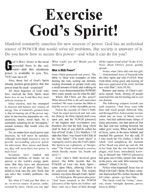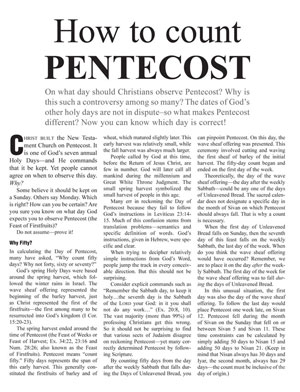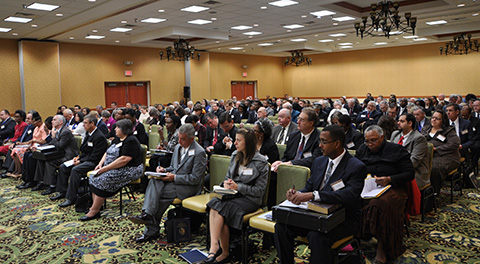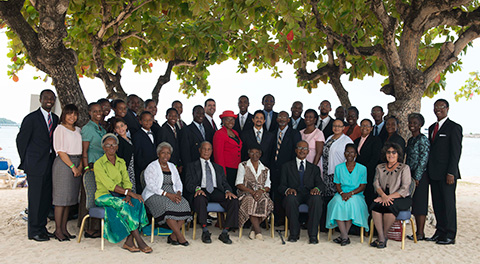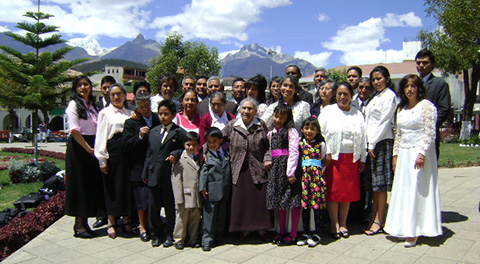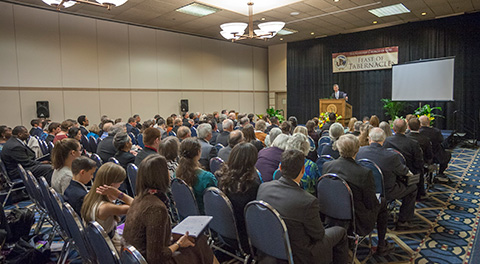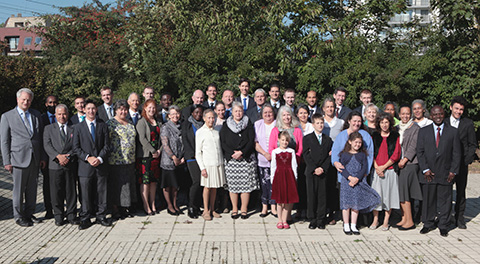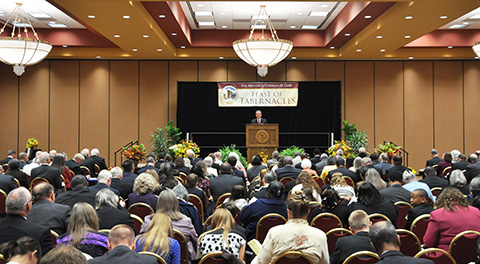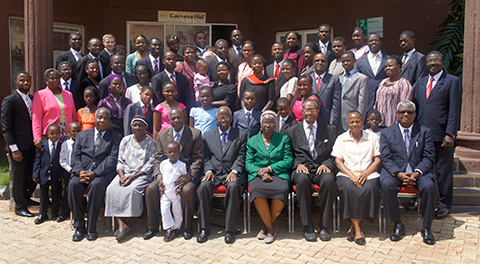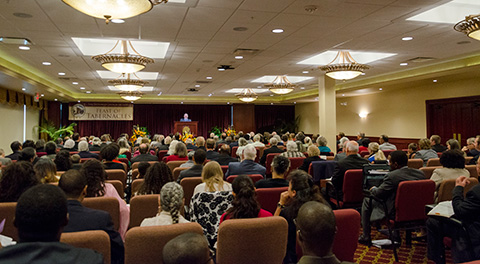Christ built the New Testament Church on Pentecost. It is one of God’s seven annual Holy Days—and He commands that it be kept. Yet people cannot agree on when to observe this day. Why?
Some believe it should be kept on a Sunday. Others say Monday. Which is right? How can you be certain? Are you sure you know on what day God expects you to observe Pentecost (the Feast of Firstfruits)?
Do not assume—prove it!
Why Fifty?
In calculating the Day of Pentecost, many have asked, “Why count fifty days? Why not forty, sixty or seventy?”
God’s spring Holy Days were based around the spring harvest, which followed the winter rains in Israel. The wave sheaf offering represented the beginning of the barley harvest, just as Christ represented the first of the firstfruits—the first among many to be resurrected into God’s kingdom (I Cor. 15:20-23).
The spring harvest ended around the time of Pentecost (the Feast of Weeks or Feast of Harvest; Ex. 34:22, 23:16 and Num. 28:26; also known as the Feast of Firstfruits). Pentecost means “count fifty.” Fifty days represents the span of this early harvest. This generally constituted the firstfruits of barley and of wheat, which matured slightly later. This early harvest was relatively small, while the fall harvest was always much larger.
People called by God at this time, before the Return of Jesus Christ, are few in number. God will later call all mankind during the millennium and Great White Throne Judgment. The small spring harvest symbolized the small harvest of people in this age.
Many err in reckoning the Day of Pentecost because they fail to follow God’s instructions in Leviticus 23:14-15. Much of this confusion stems from translation problems—semantics and specific definition of words. God’s instructions, given in Hebrew, were specific and clear.
When trying to decipher relatively simple instructions from God’s Word, people jump the track in every conceivable direction. But this should not be surprising.
Consider explicit commands such as “Remember the Sabbath day, to keep it holy…the seventh day is the Sabbath of the Lord your God: in it you shall not do any work…” (Ex. 20:8, 10). The vast majority (more than 99%) of professing Christians get this wrong. So it should not be surprising to find that various sects of Judaism disagree on reckoning Pentecost—yet many correctly determined Pentecost by following Scripture.
By counting fifty days from the day after the weekly Sabbath that falls during the Days of Unleavened Bread, you can pinpoint Pentecost. On this day, the wave sheaf offering was presented. This ceremony involved cutting and waving the first sheaf of barley of the initial harvest. The fifty-day count began and ended on the first day of the week.
Theoretically, the day of the wave sheaf offering—the day after the weekly Sabbath—could be any one of the days of Unleavened Bread. The sacred calendar does not designate a specific day in the month of Sivan on which Pentecost should always fall. That is why a count is necessary.
When the first day of Unleavened Bread falls on Sunday, then the seventh day of this feast falls on the weekly Sabbath, the last day of the week. When do you think the wave sheaf offering would have occurred? Remember, we are to place it on the day after the weekly Sabbath. The first day of the week for the wave sheaf offering was to fall during the days of Unleavened Bread.
In this unusual situation, the first day was also the day of the wave sheaf offering. To follow the last day would place Pentecost one week late, on Sivan 12. Pentecost fell during the month of Sivan on the Sunday that fell on or between Sivan 5 and Sivan 11. These time constraints can be calculated by simply adding 50 days to Nisan 15 and adding 50 days to Nisan 21. (Keep in mind that Nisan always has 30 days and Iyar, the second month, always has 29 days—the count must be inclusive of the day of origin.)
The Meanings of “Sabbath” in Hebrew
Read God’s simple instructions in Leviticus 23:15-16:
“And you shall count unto you from the morrow after the Sabbath, from the day that you brought the sheaf of the wave offering; seven Sabbaths shall be complete: Even unto the morrow after the seventh Sabbath shall you number fifty days; and you shall offer a new meat [meal] offering unto the Lord.”
The two main things people misunderstand are: (1) The meaning of the term “Sabbath” in both verses above, and (2) the meaning of the term “from” in verse 15.
Two Hebrew terms are translated as the English word “Sabbath.” The first is Shabbat. At the time of Moses, it meant the weekly Sabbath day or an annual Sabbath (Holy Day). Later, after the time of Hellenistic influence over Judea (second century B.C.), Shabbat also meant “week.” By the time of the New Testament, it came to be used interchangeably for both “week” and “Sabbath day” in Greek.
But using the word Sabbath as “week” (Lev. 23:15-16) was an error that some made in counting Pentecost. In context, the term Sabbaths could be defined as “weeks” (vs. 15) without changing the meaning. But to interpret the other two words (“Sabbath” in vs. 15 and 16) as “week” completely changes the meaning.
Even in Deuteronomy 16:9, which also instructs how to count Pentecost, the word translated as “weeks” originated from the term shavuah or shabuwa: “Seven weeks shall you number unto you: begin to number the seven weeks from such time as you begin to put the sickle to the corn.”
During the time of Moses, the word for “week” was shavuah, which means a period of seven days. The plural for shavuah is shavuot. Thus, the Feast of Weeks was called the Feast of Shavuot. To this day, the Jews call this Holy Day “Shavuot.”
By reading the scriptures in English or some other modern language, we do not know whether the term “Sabbath” (especially in the Books of the Law) originally meant shavuah for week, shavuot for weeks, or Shabbat for weekly Sabbath Day or annual Sabbath Day. Since the translations are ambiguous, a Hebrew lexicon must be studied to understand the original meaning and be doctrinally correct. We will shortly see how this was misinterpreted by some.
The Meaning of “From” in Hebrew
Another common error in English translations is misunderstanding the preposition from. Review Leviticus 23: “And you shall count unto you from the morrow after the sabbath, from the day that you brought the sheaf of the wave offering; seven sabbaths shall be complete” (vs. 15).
In English, when people refer to time, “from” is most always used exclusively. For example, if a man asks his friend to meet him one week from today, he wants his friend to meet him one week from that very day. The intent of the English understanding excludes the starting day, effectively numbering it “day zero.” The following day would be “day one.” This is all implied in the meaning of the English preposition “from.” It excludes the day of origin.
Many other modern languages do not imply this. In French and German, the phrase “one week from today” means the same day of the week one week later, as in English. But it would be considered eight days from the present day.
In both these languages, the preposition “from” would be inclusive when counting from a point in time. The day of origin is “day one,” not “day zero.” Thus, one week from now would be eight days away.
In Hebrew, “from” (min) is also inclusive in relation to time. The day of origin is counted, as well as the concluding day. This is true in both modern and ancient Hebrew.
Min, as understood in Leviticus 23:15, includes counting the day of origin, as well as the concluding day. But even if there were doubt about this (which there is not), verse 16 tells us precisely which day of the week to target: “And you shall count unto you from the morrow after the sabbath, from the day that you brought the sheaf of the wave offering; seven sabbaths shall be complete: Even unto the morrow after the seventh sabbath shall you number fifty days; and you shall offer a new meat [meal] offering unto the Lord.”
The correct day is clearly “the morrow after the seventh Sabbath [Shabbat, meaning Sabbath day].” The day after the Sabbath (not a High Day, but the weekly Sabbath) was, and always has been, the first day of the week—Sunday. This day was determined by counting from—and including—the day of the wave sheaf offering. Verse 16 leaves no doubt. Again, “the morrow after the Sabbath” is the first day of the week. According to Scripture—God’s Word —Pentecost is always to be observed on a Sunday.
How Jewish Sects Reckoned Pentecost
There are at least four ways various Jewish sects determined Pentecost. All four methods correctly count fifty days (day of origin included), but three count from the wrong day.
The Pharisees established the method followed by most Jews today. The rabbinic Jewish tradition adopted their method, which dates back to the early centuries A.D. Instead of using the day after the weekly Sabbath, the Pharisees assigned the wave sheaf offering to the day following the first High Day, regardless of the day of the week that it fell upon.
One obvious inconsistency is that by always counting from Nisan 16 (the day after the first High Day) the target date should always be Sivan 6, regardless of the day of the week. If the day God determined for Pentecost had been a set date on the sacred calendar, it would NOT be necessary to count in the first place!
Using this method, the Pharisees were correct about 25% of the time.
First, recognize that the Pharisees’ and modern Jews’ method of counting Pentecost always leads to the correct day when the day of origin is correct. Refer to the sacred calendar, which the Jews still use. Take special note of every year when their Passover falls on the seventh day of the week. (Modern Jews observe the Passover one day late, on the first day of Unleavened Bread—Nisan 15.) The next day after this double Sabbath (both a weekly and High Sabbath) would be the correct Sunday of the wave sheaf offering. Counting fifty days from Nisan 16 takes us to Sunday, Sivan 6—the correct day for Pentecost. This illustrates why about 25% of the time, the Jews arrive at the correct day for Pentecost.
The Falasha and Qumran Sects
The second group, the Falashas of Ethiopia, dates back to the time of Menelek, son of King Solomon and the Queen of Sheba (Encyclopedia Britannica, 11th ed., Vol. 10, p. 137). Although renowned for their zeal and devotion, many of their beliefs and traditions differed from mainstream Judaism. This group recognized the command in Leviticus 23:15 to count from a Sunday, but counted from the first Sunday following the last Holy Day of Unleavened Bread. Using this method, the Falashas always observed Pentecost on a Sunday in Sivan. That Sunday, however, was always one week late.
As with the Pharisees, their mistake was misinterpreting the term Shabbat in Leviticus 23:15-16. They considered Shabbat to mean “week or weeks,” when it actually meant weekly Sabbath day or annual Sabbath Day. By rendering Shabbat as “week,” each group selected the wrong day for the wave sheaf offering and kept Pentecost on the wrong day.
The third group, the Qumran sect, authored the Dead Sea Scrolls. Their calendar departed from the sacred calendar radically. This most likely resulted from Hellenistic influences and pressures.
Unlike the Pharisees, who always counted from the day following the first day of Unleavened Bread, the Qumrans counted from the day following the last day. Thus, Pentecost always fell on the 15th day of Sivan. The last day of Unleavened Bread always fell on the weekly Sabbath. Counting fifty days from the day following the weekly Sabbath, they arrived at a Sunday.
Like the Falashas, they always kept Pentecost late. Their calendar was so distorted that they not only observed Pentecost on the wrong day, but also erred with the date of Passover and the days of Unleavened Bread.
Who Correctly Reckoned Pentecost?
However, three groups did observe Pentecost on the correct day. The largest and main group were the Sadducees, prominent during the time of Christ and the apostles. This sect was predominately secular in nature and, unlike the Pharisees, did not pretend to be zealous. Their power and influence were political—not religious (Encyclopedia Britannica, 11th ed., Vol. 23, pp. 989-990).
Although the Sadducees gave only minimal allegiance to their religion, their method of counting Pentecost was correct. The high priests who served during the first century (until A.D. 70) were Sadducees. They were in charge of the temple as Pentecost arrived in A.D. 31. By keeping the correct day, and with thousands of orthodox Jews present in Jerusalem, the stage was set for Christ to miraculously build the Church of God (Acts 2).
The Samaritans (who called themselves Jews, but were not) also kept the right day. Although their religion radically differed from Judaism, the Samaritans did follow the sacred calendar and observed Pentecost at the correct time. Yet, they were corrupted with a mixture of many religions, called “syncretism.” This practice of blending religions was commonly practiced by certain nations and peoples. The Samaritans were the most notorious.
The third group that correctly reckoned Pentecost was the Karaites (or Qaraites). Unlike other Jewish sects, this group appeared later, beginning in the eight century A.D. Their movement began around Baghdad in the early A.D. 700s (Encyclopedia Britannica, 11th ed., Vol. 22, p. 705).
The Karaites were also unique because they emerged from rabbinical Judaism, but came to reject it. They returned to Scripture as their basic authority, a move that was unheard of in the history of Judaism.
“Karaites” derives from the Hebrew term quara—“to read” or “readers.” They were also called “children of the text” because of their avid devotion to reading the scriptures. Their founder was a Talmudist named Anan. Rabbinical advocates opposed him because he rejected most of their traditions, in favor of Scriptural authority.
Influenced by the True Church
Some beliefs adopted by Anan and his followers were also unique to God’s Church. One was believing that Passover should be observed on the evening of Nisan 14 as the Bible commands, instead of the 15th.
Another was their observance of Pentecost. The Karaites kept it at the same time as the Sadducees and the Samaritans. However, the Karaites denied any association with the other two sects, “with neither of whom they have any historical connection or much spiritual affinity” (Ibid.).
In addition to dismissing rabbinical Judaism in favor of Scriptural authority, there is other evidence that the Karaites had been exposed to the influence of the Church of God. In about A.D. 325, under impending persecution and death, the true Church fled from the eastern boundaries of the Roman Empire. Many of the Jewish Nazarenes (or Ebionites, as they came to be called) emigrated from Syria toward the areas around Baghdad. Many rabbinical Jews also fled, especially toward the southern areas. The Church had some influence in that region, although they were relatively few among the other Jewish exiles.
By the time Anan founded the Karaites, the main source of influence was the Paulician movement just to the north. Of this movement, Gibbon said, “…many Catholics were converted…by his [Constantine of Mananali, the original Paulician leader’s] arguments; and he preached with success in the regions of Pontus and Cappadocia, which had long since imbibed the religion of Zoroaster” (Decline and Fall of the Roman Empire, Gibbon, p. 389). Zoroastrianism was the religion of the former Persian Empire.
The probability that this movement was unknown to the Jews of Baghdad would have been remote. The Paulician effect there was strong during and after the time of Constantine of Mananali. The Church of God was in a position to influence the Karaites by doctrine, as well as by example. There is no evidence that the Karaites were ever part of the true Church, although a few could have been. The Karaites’ practice of correctly observing Passover and Pentecost reflected the influence of the Pergamos Era (Rev. 2 and 3) of God’s Church.
Forward “unto perfection”
The original instructions for counting Pentecost were given in ancient Hebrew. Some err in reckoning the day of Pentecost, but by studying the original intent of key Hebrew terms, it is easy to prove when Pentecost should be kept.
“Modern Hebrew scholarship has ascertained the original implications of those instructions in a way not even possible centuries ago. It is clear that Pentecost was to be kept on a Sunday seven weeks after the wave sheaf Sunday during the Feast of Unleavened Bread.
“The Old Testament instructions are further buttressed by a study of the New Testament and Jewish history. During the time of Jesus, Pentecost was kept by the official priesthood on a Sunday. There is no evidence that Jesus disagreed with the normal times for keeping the festivals, even though His keeping of them is mentioned several times. Jesus’ example is very significant” (“How to Reckon the Day of Pentecost,” Worldwide Church of God).
With a clear understanding of the original Hebrew terms, we can be confident that we are observing Pentecost on the correct day.
Just as the technical details are crucial, so is the meaning of this vital Holy Day. In the spirit of Hebrews 6:1, we should build upon this foundational understanding and move forward “unto perfection.”

